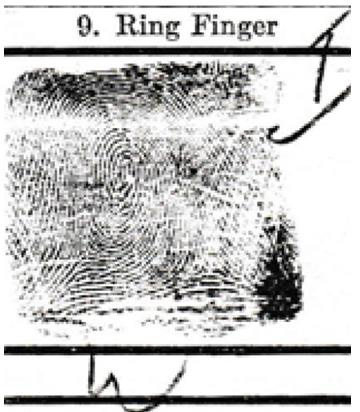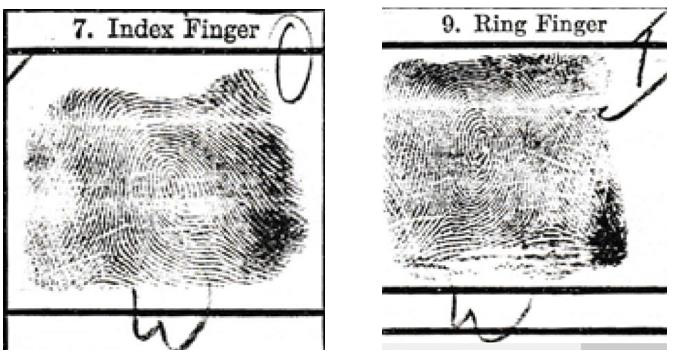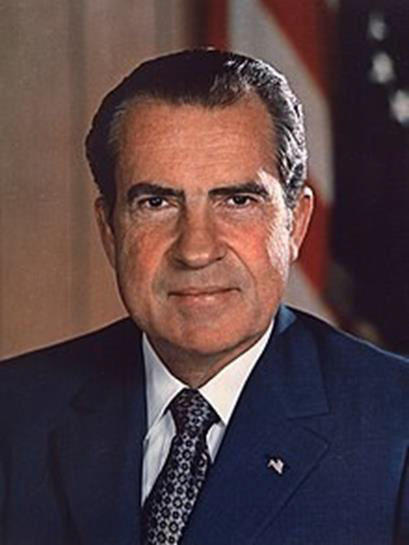Mini Review 
 Creative Commons, CC-BY
Creative Commons, CC-BY
The Fingerprints of President Richard Milhous Nixon
*Corresponding author: Andrés J Washington, Department of Forensic Medicine and Deontology, Faculty of Medicine, Medical University, NY, USA.
Received: October 14, 2021; Published: October 22, 2021
DOI: 10.34297/AJBSR.2021.14.002012
Abstract
The name Richard Nixon, 1913-1994 will spark an interest of discussion when mentioned. There is however, another chapter to be explored, the president’s fingerprints. Forensic Science tells us that all fingerprints are attributed to a single individual. However, discovery of the frequency of fingerprint classifications can reveal additional information about ability, talent or mental elevation in that there is a correlation to this aspect of humanity. Mental elevation is the focus of my interest. [1] And we cannot deny that the former president was brilliant in many ways. President Nixon’s number 2, 7 and 9 digits displayed fingerprint classifications unique enough to be worth mentioning.
Keywords: Richard M Nixon, Fingerprints, Radial Loop, Central Pocket Loop, NCIC FPC, Frequencies
President Nixon’s outstanding frequencies are as follows:
Digit # 7 is a Central Pocket Loop Type Whorl pattern with an
outer tracing. The NCIC FPC is CO [2].
Note that it has a radial profile!
The frequency of CO on the # 7 digit is the following:
367016/ 17951192 = 2.04452161171247/100
2.04452161171247
In words = two and four trillion four hundred fifty- two billion
one hundred sixty-one million one hundred seventy-one thousand
two hundred forty-seven hundred-trillionths [3] (Figure 1).
Digit # 9 is a Central Pocket Loop Type Whorl pattern with an
inner tracing. The NCIC FPC is CI.
The frequency of CI on the # 9 digit is the following:
1482915/17951192 = 8.2608163290772/100
8.2608163290772
In words = eight and two trillion six hundred eight billion one
hundred sixty-three million two hundred ninety thousand seven
hundred seventy-two ten-trillionths (Figure 2).
In addition, the number two digit is a Radial loop with a ridge
count of 17. The NCIC FPC is 67.
The frequency is the following:
176202/17951192 = 0.9815615586976063/100
0.9815615586976063
In words = nine quadrillion eight hundred fifteen trillion six
hundred fifteen billion five hundred eighty-six million nine hundred
seventy-six thousand sixty-three ten-quadrillionths (Figures 3&4).
The above fingerprint record provides a primary classification of 9 over 4 because different numerical values were assigned to the ten digits. In the above calculation arrangement, the value of even numbered digits over odd, instead of right hand over left are assigned. This was so that a greater distribution of primary classifications could be accomplished for filing. The count of 1 is added to the value of the numerator and denominator for consistency (Figure 5).
In the Fingerprint Geometric Analysis model, the use of the Primary Classification from the Henry System of Fingerprint Classification and Filing shows the total numerical values assigned to the ten digits, right hand as numerator over left hand as denominator instead of the total value of even numbered digits as the numerator over the total value of odd numbered digits as the denominator. The objective here is not filing but to create a geometric design to represent primary classifications [4].
When taking both male and female frequencies into account digits with a high frequency of whorls are assigned a lower numerical value. Digits with a low frequency of whorls are assigned a higher numerical value. This is to make all primary classifications more compatible with digit whorl frequencies.
Primary Classification First Reference Sequence (Chart 2)
President Nixon’s Primary Classification is 2 over 7, it is
displayed as 2/7 on the Primary Classification First Reference
Sequence.
Included classifications represent individuals compatible
in working together. Intersected classifications are not
compatible with those in which the classifications are included.
Encompassed classifications can be controlled by those of the
primary classifications of 2/7, 11/28 and 7/20. The geometric
representation for 2/7 is displayed on the Primary Classification
First Reference Sequence (Figure 6) (Chart 3).
An added mention on the central pocket frequencies:
Here we draw our attention to the two Central Pocket Loop
Type Whorl patterns on digits # 7 and #9. They are opposite to
one another in that digit # 7 has an outer tracing and is radial
in formation while digit # 9 has an inner tracing and is ulnar in
formation (Figure 7).
Conclusion
It should be noted that the frequency of whorl patterns for
the male population shows a higher frequency to lower frequency
of whorls to be the same for both right and left hand. Thus, the
numerical values assigned to each digit is the same for both the
right and left hand. The values are: 1=2, 2=4, 3=8, 4=1, 5=16, 6=2,
7=4, 8=8, 9=1 and digit # 10=16.
Additionally, numerical values for the female digits are assigned
according to an equal standard. Thus, the numerical values assigned
to the female ten digits are as follows: 1=1, 2=4, 3=8, 4=2, 5=16,
6=1, 7=4, 8=8, 9=2 and digit # 10=16.
However, when using Primary Classification Analysis in the
Fingerprint Geometric Analysis model, the frequencies of both
male and female whorl patterns are combined to discover a total
distribution of whorl type patterns. Thus, the numerical values for
male and female are as follows: 1=2, 2=4, 3=8, 4=1, 5=16, 6=1, 7=4,
8=8, 9=2 and digit # 10=16.
It must be pointed out that in the aforementioned description
of male and female frequencies, the male frequency values are
coincidental to the right hand and the female frequency values are
coincidental to the left hand! (Figures 8&9).
References
- Washington AJ (2016) The correlation between the elevation of the mental manifestation and the phenomenon of the dermal ridge arrangements. Forensic Res Criminol Int J 2(2): 72-80.
- FBI (2006) The Science of Fingerprints Classification and Uses.
- Washington AJ (2000) Distribution of NCIC FPC Including 17,951,192 Males.
- Washington AJ (2016) Sacred geometry. Forensic Res Criminol Int J 2(2): 56-61.















 We use cookies to ensure you get the best experience on our website.
We use cookies to ensure you get the best experience on our website.